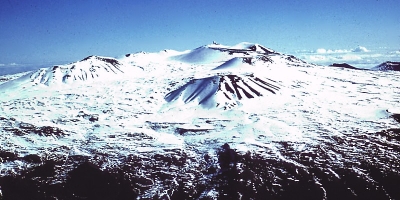
Mauna Kea is a dormant volcano on the island of Hawai?i. Its peak is 4,207.3 m (13,803 ft) above sea level, making it the highest point in the state of Hawai?i and second-highest peak of an island on Earth. It is about a million years old, and has thus passed the most active shield stage of life hundreds of thousands of years ago.
With its high elevation, dry environment, and stable airflow, Mauna Kea’s summit is one of the best sites in the world for astronomical observation. Since the creation of an access road in 1964, thirteen telescopes funded by eleven countries have been constructed at the summit. The Mauna Kea Observatories are used for scientific research across the electromagnetic spectrum and comprise the largest such facility in the world. Their construction on a landscape considered sacred by Native Hawaiians continues to be a topic of debate to this day.
The geologic landscape of Hawaii’s islands has changed greatly over time, which has also impacted its ecologic landscape. As Hawaii’s volcanic islands rise and fall, organisms must adapt to a series of transitional habitats both above and below the ocean surface. In terms of the habitats and species that are part of Mauna Kea—from its mountain peak to its ocean deep—the colossal mountain is not only tall, but high in biodiversity as well. Mauna Kea’s variety of terrestrial habitats includes stone deserts, shrublands, alpine woodlands, and tropical forests. These varied habitats are home to several endemic species that are only found on Hawaii or the Hawaiian archipelago. The ocean habitats that characterize Mauna Kea are equally varied and full of life. The greatest quantity of marine life is found between the surface and a depth of 1,189 meters (3,900 feet, 0.7 miles) in the sunlight zone and twilight realm. Below 3,900 feet are the midnight zone and abyss, which are dark, cold, under high pressures, and lacking in food. Species in these extreme environments have developed unique adaptations to regulate their temperatures, protect themselves, help them locate food, communicate, and find mates.
Picture Credit : Google




